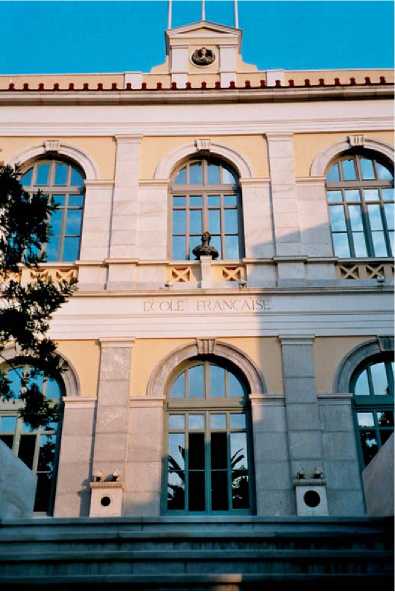Abaton In Greek, portico for incubation. In this kind of
Dormitory, the sick waited for the god to appear in their sleep and to give them the way of recovery. agora In Greek, public place. They were multifunctional. andron (pl. andrones) In Greek, reception room for men. archaeometry Combining of scientific techniques and traditional methods of history and archaeology. bouleuterion Greek term to design the Council Chamber. ceUa Latin term for the main room of the Greek temple, the naos. It is generally preceded by the pronaos.
Doric and Ionic order In classical architecture, a column (without base in Doric order, with a base in Ionic order) with shaft, capital, and entablature. The number of flutes, the form of the capital, and the decoration of the entablature vary between the two orders. The Doric order has been employed mainly in central Greece, south Italy, and Sicily, while the Ionic order originated in Asia Minor.
Dynast Sovereign, ruler of a little country or ruling under the protection of a great power.
Heroon Funerary enclosure or monumental tomb of various forms, designed for a hero and, by extension, for a prominent figure.
Hestiatoreion In Greek, public room for banqueting. hysplex Greek term for the system of departure of the race in the stadium.
Kouros (pl. kouroi) Greek term for the young male. It designs the male statue of Archaic Period. The female statue is the kore (pl. korai).
Naiskos (pl. naiskoi) In Greek, diminutive of naos. The term refers to a kind of little chapel with pillars or columns in front and a pediment. Naiskoi were used as funerary monuments, expanded grave reliefs, especially in Athens Kerameikos cemetery in the fourth century BCE. palaestra Place of training for the athletes.
Pausanias Greek author and traveler of the second century CE. He wrote a Periegesis, a travel around Greece in ten books, very useful for archaeologists.
Peribolos tomb Tomb with a wall of enclosure. This kind of monumental tomb was developed in Attica in the fourth century. peribolos wall Wall of enclosure of a sanctuary. peristyle A range of columns surrounding a building or an open court.
Philology Study of written documents.
Pliny the Elder Latin author of the first century CE. He wrote the Historia Naturalis, encyclopedia in 37 books. In books XXXIII-XXXVII (ores, metals, stones), he deals with history of art. Plutarch Greek author of the first and second century CE. pronaos In Greek, before the temple (naos). The pronaos is the first room when entering the temple. stele Rectangular and vertical stone used as a surface of
Engraving and/or painting and sculpture. In funerary context, it designs the relief monument above the tomb. stoa (pl. stoas) Portico in Greek.
Tholos Round building. The term is also used to design the Mycenaean chamber tombs.
Vitruvius Latin author and architect of the first century BCE. He wrote De Architectura, a treatise of architecture in ten books.
When it comes to Greek archaeology, one must have in mind that the very word ‘archaeology’ comes from ancient Greek and meant at that time ‘‘a history or a legend of the past’’ (as put by Plato: ‘‘They are very fond of hearing about the genealogies of heroes and men, Socrates, and the foundations of cities in ancient times and, in short, about antiquity [archaeologia] in general.’’, Hippias Major, 285d), or in the terms of Thucydides, ‘‘to talk about ancient things’’ (VII, 69,2).
Archaeology in present-day Greece is a well-known discipline and its origins should be found first in the Renaissance and most precisely in the philological tradition. Nevertheless, some knowledge of ancient texts has always been transmitted over generations, including during the Middle Ages, when manuscripts were kept and recopied within monasteries and libraries. The Renaissance marked an important moment for this transmission, either by descriptions of the antiquities seen by travelers, such as Cyriacus of Ancona (1391-1455), or by an increasing interest in, and an intellectual reappraisal of, the ancient literature. The editing of ancient texts by intellectuals all over Europe resulted in another discipline, philology, a word that appeared only in the eighteenth century. The discovery of archaeological remains in Herculaneum and then in Pompeii started a stronger regain of interest in antiquity: noble and wealthy families became interested in acquiring and collecting works of art coming from ancient sites. In the second half of the eighteenth century, intellectuals, artists, and cultivated people also started traveling to those ancient remains, especially in Italy and Sicily, the so-called Grand Tour.
Even though we have the testimony of various Western travelers from previous periods, visits to Greece were eased only after its independence in 1831, after 10 years of war against Ottoman rule. At the beginning of the nineteenth century, when nationstates were being established in Europe, Greek and Roman cultures were perceived as the cradle of Western civilization and started to be studied as such (see Civilization and Urbanism, Rise of). The example of Lord Byron, who went to Greece to fight for its independence, is symptomatic of the intellectual link between Western European countries and their claim for a common culture with ancient Greece. For a long period, Greek archaeology was actually the simple collection of works of art, what we can call antiquari-anism, and almost no attention was given to the contexts of discovery. Archaeology was not yet a discipline, but only a private activity sponsored by the nobility.
A turning point was represented by the establishment of the international schools in Athens, the first of which was the Ecole Franc:aise in 1846 (Figure 1) (followed by the British, German, American, and

Figure 1 Athens, French School of Archaeology (EFA): main building, library (nineteenth century).
Italian, among others), responsible for the study of the antiques and not only their collection by private nobles. It coincides with the development of archaeology as a discipline and with the beginning of the great excavations in Greek ancient sites, in particular some of the most important sanctuaries of the Greek world (Olympia, Delphi and Delos). Another important achievement of the incipient discipline of Greek archaeology was the discovery and excavation of the site of Troy, by H. Schliemann and W. Dctrpfeld in 1871.
Greek archaeology has some problems of definition, geographical and chronological. The ancient Greek world does not coincide with present-day Greece, which somehow is an insolvable problem. Most of the ancient Greek cities established in the Anatolian coast (actual Turkey) are included in what is called Greek archaeology, but ancient Greek colonies on the Black Sea and in Italy, Sicily, France, and Spain are most commonly treated separately (see Europe, South: Greek Colonies).
The other definition problem is chronological. In a broad sense, Greek archaeology would comprehend prehistoric and historical periods together, going through several centuries, from the Minoan civilization (second millennium BCE) until at least the Roman conquest in the second century BCE. On the other hand, due to the increasing specialization of the discipline, Minoan and Mycenaean periods, that is, the period before the advent of Greek city-states at the beginning of the first millennium BCE, are usually considered as independent branches of Greek archaeology.




 World History
World History









